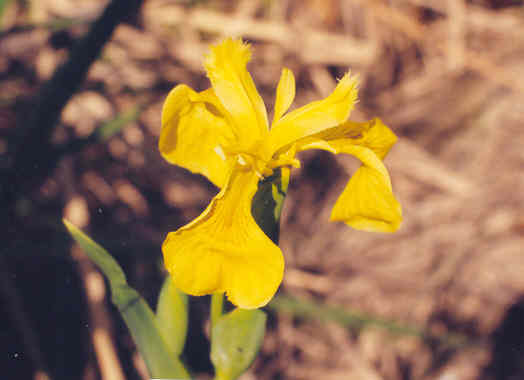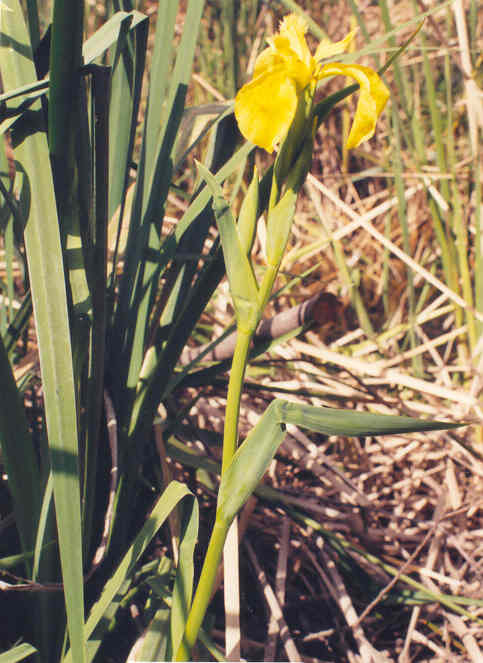
Iris pseudacorus L.
 |
Iris pseudacorus L.
Iridaceae (Iris Family)Europe, North Africa, SyriaIris |
March Photo
Plant Characteristics: Robust, rhizomatous plants forming large strong clumps; lvs. dark green, flat, sword shaped, up to 1 m. long, 3 cm. wide, entire, with many vertical veins, mostly basal but a few on the st.; fls. showy, yellow, several per stem but blooming one at a time; falls, beardless, 6 cm. long, 4 cm. wide and narrowing at the haft, yellow, darkening toward the haft with brown lines near the haft; standards small, erect, yellow, 1.5 cm. long, 5 mm. wide, shorter than the style branches; style branches 4 cm. long, 1.5 cm. wide, yellow with fringed ends, each divided in half along the wide axis for the last 1 cm. and recurved at the tips; stamens 3, covered by the style branches, filaments connected at the bottom of the tube, anthers 1.3 cm long, filament +/- the same; ovary three celled, caps. oblong, many seeded.
Habitat: Escape from cultivation. Found in two locations at 23rd st. one with plants growing above the water level in ground wet enough to support cattail growth and the other actually in the water.
Name: Greek, I-ris, the rainbow. (Bailey 266). Pseudacorus, false acorus, known as Acorus in pre-Linnaean days. (Bailey 273).
General: Rare in the study area with only two clumps of plants known, these in the creek bed at 23rd St. One clump is approx.1.5 x 1 m. and the other much smaller. (my comments). Several native iris species were used by the Indians of northern California. The Hoopa, Karuk, Yurok and other tribes would gather large bundles of the leaves and extract a single silky fiber for each leaf margin. These fibres are surprisingly strong and flexible. In the fall large bundles of leaves were stored until needed. The fibres were used to make fishing nets, string, rope and snares for catching deer, birds and other game. In spite of the excessive labor required to prepare Iris fiber materials, this fiber was one of the most generally used in northwestern California. (Murphy 1959; Strike 1994). While fresh iris roots and rhizomes may be toxic, a number of external uses were successfully used on infected wounds, ulcers, fistulas and to remove freckles. A poultice of the raw rhizome was effective against staph sores. Only the dried root or rhizome was used internally and is active as a cathartic, has an effect on the production of pancreatic enzymes and bile, is a strong diuretic and will stimulate sweat and saliva. Iris should be used preferably in combination with other less stimulative plants. (Stevens, Michelle L., "ETHNOECOLOGY OF SELECTED CALIFORNIA WETLAND PLANTS" FREMONTIA, A Journal of the California Plant Society, Vol. 32 No.4, October 2004 pp. 7-15). Probably upward of 150 species in the north temperate zone; several species are well known plants and many other are prized by fanciers. (Bailey 266). Huxley lists several hybrids of I. pseudacorus, most originating in Japan. I. ensata x I. pseudacorus has large, bright yellow flowers with red-brown veins on the falls. (Huxley, Vol. II 676). The flower description in Bailey mentions a bright spot on the haft; Huxley does not mention this spot and describes the brown veins that my specimen has. (my comment).
Text Ref: Bailey 266; Sunset Editors, New Western Garden Book 1984, 332; Huxley Vol. II 676.
Photo Ref: March-April 2000 # 5,6,7,8.
Identity: by John Johnson, confirmed by R. De Ruff.
First Found: May 2000.
Computer Ref: Plant Data 524.
Plant specimen donated to UC Riverside in 2004.
Last edit 8/6/05.
 |
March Photo